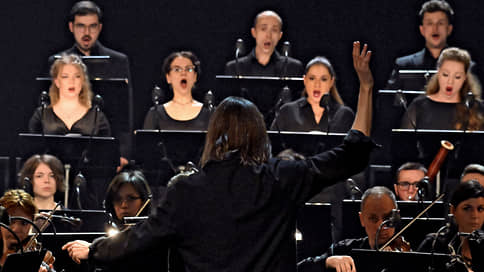Haydn, Schoenberg and Honegger at the Epiphany Festival of the New Opera
[ad_1]

The axis of the current Epiphany Festival at the New Opera Theater were the themes of war and peace (the festival started with the interpretation of Prokofiev’s score “War and Peace”), the collision of the “enduring” (eternal) and the “transient” (earthly), human life and death, the last judgment on the world. In this context, the playbill included, in particular, Verdi’s “Requiem”, Franz Schmidt’s oratorio “The Book with Seven Seals” (Russian premiere) and other works. And the concert block of the festival opened with an original program by conductor Philip Chizhevsky, performed by the Questa Musica choir and orchestra, soloists of the New Opera and the Bolshoi Theater Youth Program. Tells Irina Mikhalkina.
The starting point in Chizhevsky’s program was Haydn’s “Missa in tempore belli” (“Mass during the war”), also known as “Mass with Timpani,” created in 1796. This was the year when a general mobilization was declared in Austria in anticipation of an invasion by the French army and the government issued a decree according to which “no Austrian should speak of peace until the enemy is driven back to his normal borders.” Meanwhile, the forbidden word, although in Latin, is heard more than forty times in Haydn’s Mass, which became for him a kind of “prayer for peace.” And this message of his composition, as well as his emotionally upbeat tone, contrary to the strict canon of the liturgical genre, as well as the operatic beauty of the solo parts (Haydn was not accidentally reproached for ignoring the then accepted style of church music – stile antico), not only captivated the audience, but also are still perceived as Haydn’s innovation in this genre. Chizhevsky’s mass sounded like a living, creative text, genre-bending to both opera and cantata. In the flexible, fast movement of the musical fabric performed by Questa Musica, all components were balanced – soft dynamics, balanced sound of the orchestra and voices, touching and beautiful sound of the choir, a clean, clear ensemble of soloists (soprano – Elena Gvritishvili, mezzo-soprano – Polina Shamaeva, tenor – Georgy Faradzhev, bass – Konstantin Fedotov), a joyfully upbeat tone that affirms faith in life, and not the fear of death. The final words of the Mass in the Agnus Dei – “dona nobis pacem” (“Give us peace”) – sounded like a jubilant and excited postulate, like a formula for Haydn’s firm faith in the victory of light and reason.
The second composition of Chizhevsky’s program turned out to come from the beginning of the twentieth century, from the era of global antagonisms that ultimately resulted in the First World War – “Friede auf Erden” (“Peace on Earth”) by Schoenberg to the poems of Conrad Ferdinand Meyer (1907). The refrain of the composition, written for an a capella choir and based on the Gospel story about the Nativity of Christ, was the words “Peace, peace on earth!” and the belief that “a semblance of justice exists / Amid murder and horror.” The most difficult score, where Schoenberg built polyphonic technique into the harmonic textures – canons, counterpoints, strettas, where chords are replaced by layers of sounds that require colossal choral coordination and intonation precision, was performed in the first author’s version – without an orchestral part, which Schoenberg added later to facilitate difficulties for performers. The four verses of “Peace on Earth”, telling about the coming of the shepherds to Bethlehem to the born baby, about the horrors of discord, lawlessness and bloody deeds of people, about the belief that there is a will on earth to create peace, were performed by the Questa Musica choir in a narrative tone, like Bach’s Passions. Instead of emotions there are subtle dynamic solutions, and in the polyphonic textures there is an almost tangible beauty of Schoenberg’s sound picture with its contrasts of deepening darkness, the intonations of human suffering and the final triumph – the repeated “Friede auf Erden” (“Peace on Earth”) many times over. As a universal prayer, alas, which did not save the world from the First World War.
A message from the next war that engulfed the world was Arthur Honegger’s famous Second Symphony for string orchestra and trumpet, written in occupied Paris in 1942. This score bears the imprint of a gloomy reflection on France’s defeat in the war (even if Honegger himself did not intend such an interpretation). For Chizhevsky, the introduction of the symphony sounded with a gloomy, drawn-out sound, as if emerging from the depths of a suppressed consciousness. The entire dramaturgy of this part was built by the conductor on sharp contrasts, dominated by a depressive background and the stabbing, “merciless” sound of the exploding, energetic Allegro. In the passacaglia, Chizhevsky thickened the darkness and depressed mood of the symphony even more, increasing the dynamics not by external means, but by the internal tension of sound, the pressure of a gloomy tone that achieved an expressionistic effect. In contrast, the conductor also built the infernal, “winding” movement of the third movement – sharp, chopped, almost mechanical – like an invasion, grinding sounds, on the crest of which the solid and ascetic sound of a trumpet erupted. And across the entire orchestral mass there was a “chorale”, proclaiming peace and the triumph of humanity. This is exactly what music will be heard about at the Epiphany Festival more than once.
[ad_2]
Source link






